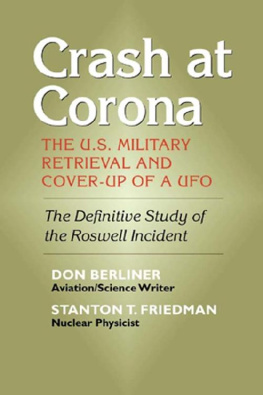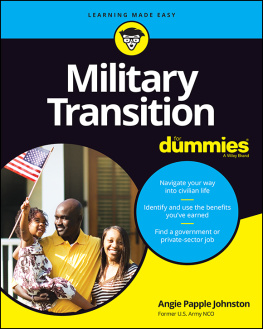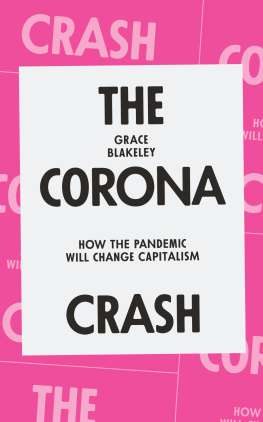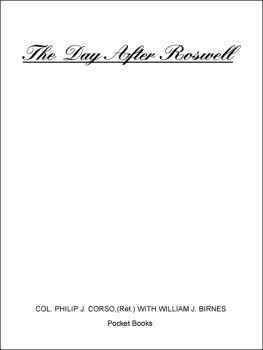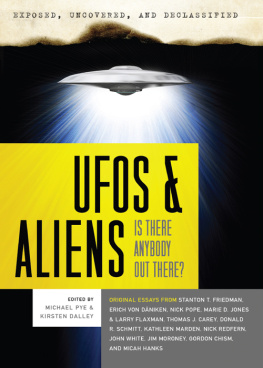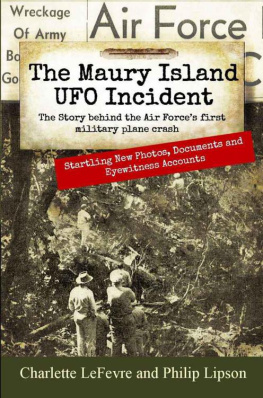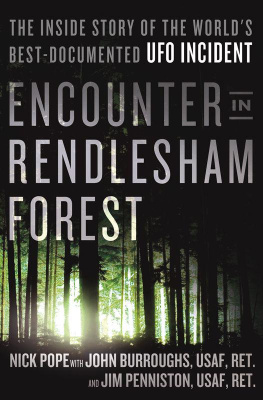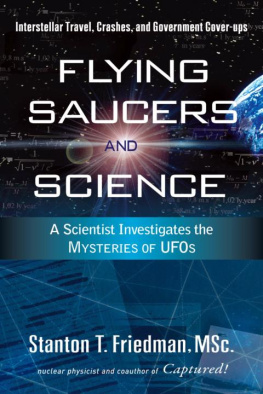
Crash at Corona: The U.S. Military Retrieval and Cover-Up of a UFO
Copyright 2004 Don Berliner and Stanton T. Friedman
All rights reserved. No part of this book may be used or reproduced in any manner whatsoever without prior written permission except in the case of brief quotations embodied in critical articles or reviews. For information, address Paraview, P.O. Box 416, Old Chelsea Station, New York, NY 10113-0416, or visit our website at www.paraview.com .
Crash at Corona was originally published by Marlowe & Company in 1992 and updated in 1997.
Cover design by smythtype
ISBN: 1-931044-89-9
Library of Congress Catalog Number: 2004103707
Contents
Acknowledgments
T HE AUTHORS WISH to express their sincere gratitude to the Fund for UFO Research and Robert Bigelow for their moral and financial support, to the hundreds of people to whom weve talked about various aspects of the crashed saucer problem, to the Mutual UFO Network for publishing so many papers about crashed saucers, to Unsolved Mysteries for its outstanding production about crashed UFOs in New Mexico, and to their agent John White and their editor Andy DeSalvo. Special thanks to Gerald Anderson, John Carpenter, Glenn Dennis, Walter Haut, Alice Knight, Vern Maltais, Dr. Jesse Marcel, Sappho Henderson, Loretta Proctor, Robert Porter, Phyllis McGuire, Elizabeth Tulk, Barbara Dugger, Robert Shir-key, L. W Rickett, General Thomas Jefferson DuBose, Jack Tiffany, researcher Renneta Friesen, and many more for their cooperation, time, and trust in us.
Stanton Friedman wishes to express special gratitude to his family for putting up with his obsession with crashed saucers and his many weeks away from home for more than a decade before finally co-authoring this long talked-of book.
Preface
R EDUCED TO ITS SIMPLEST TERMS , this is a book to answer one of the most common questions about UFOs: If they are real, why hasnt one ever crashed? The underlying implication is that since UFOs presumably dont crash, they must not be real.
The study of thousands of reports from excellent observers (airline pilots, military pilots) of close-range, daylight observations of apparently manufactured craft whose shapes and performance defy even the latest of scientific theories certainly supports the contention that some of the things reported as UFOs are almost certainly realand completely unexplained.
The lack of solid evidence that even one had crashed had bothered serious students of the subject for decades. It was hard to imagine that any constructed devices could be so flawless that they never failed. And without something more than an untraceable rumor of a crash, it was difficult to make much of a case for UFO reality, let alone alien origin.
The need for an improved, updated, more understandable and more readable book to follow the 1980 Roswell Incident by Bill Moore and Charles Berlitz had been on the mind of lecturer/researcher Stanton Friedman for many years. Having done much of the investigating for that book, he continued to dig into the crash near Corona, New Mexico. (Nothing crashed at Roswell, despite the titles of books; it was just the largest city within seventy-five miles of the crash site.) Stan spent years tracking down witnesses and widows of witnesses and neighbors and co-workers and anyone else who might be able to add even a tiny scrap to the slowly jelling story.
A plan to co-write a follow-up book with Bill Moore came to naught, but the idea and the pressing need remained. Steadily, the information and the confirmations of earlier information were piling up, and so any subsequent book would undoubtedly be stronger and more convincing. Through the 1980s, however, Friedmans only outlet for the story he was gathering through hundreds of phone calls monthly and thousands of miles of travel were formal papers (some written with Moore) published privately or presented at MUFON (Mutual UFO Network) annual conferences.
In the summer of 1989, he persuaded the producers of the NBC-TV series Unsolved Mysteries to do a major investigative segment on the Corona crash and served as a technical adviser to the show, which led off the 1989 fall season. The intense audience reaction to the original airing in September 1989 and to the rerun in January 1990 surprised everyone but Friedman. Scores of viewers called a special telephone number to record their involvement (direct, indirect, through hearsay, or imaginary) in some aspect of the mysterious events in New Mexico. This produced quite a few interesting leads, which in turn revealed a few previously unsuspected sources of valuable information. This was especially true of the lesser-known crash at the Plains of San Agustin, where a firsthand witness came forward.
In 1989, Friedman proposed a book about the new evidence for the Corona and San Agustin crashes to literary agent John White. At about the same time, aviation/science writer Don Berliner offered a similar idea to White, who had previously found him a publisher for an aviation book. White brought them together and suggested they collaborate, with Friedman concentrating on the investigation and Berliner on the writing.
The two had already worked together when Friedmans proposed investigation of the highly controversial Majestic-12 documents was financed in 1988 by the Fund for UFO Research, on whose executive committee Berliner sat. They had long been acquainted and each considered the other to be among the small group in the private UFO community whose work could be counted upon. In mid-1990, following a private conference of crash witnesses sponsored by the fund, a contract was signed and research and writing accelerated.
The search for proof of the crash of even one UFO has been a long string of frustrations punctuated by the occasional joyful discovery of a witness whose story checked out and whose background was solid. But most leads turned out to be nothing or simply couldnt be checked out at all. One woman who claimed her father had been a military doctor who performed an autopsy on an alien body was revealed to have a disturbingly active imagination, according to members of her family.
Friedman was determined to follow a strict scientific method, so he began the painstaking search through voluminous records, and files, and old newspapers. Other UFO investigators had grabbed vague rumors and built them into wonderfully detailed stories that had no basis in fact. Still others had apparently invented tales to satisfy the insatiable hunger of the press and the public for answers to questions that remain unanswered.
Each such episode, whether exposed by members of the private UFO community or by extremists in the anti-UFO clique, hurt those who were patiently sifting a mountain of sand in hope of finding a flake of gold. But enough shiny specks were found to keep the serious searchers sifting ever more sand in the hope of finding the mother lode. And even though some carefully planted fools gold turned up, the real stuff was there, too. Not the absolute proof that everyone wanted demandedbut an encouraging collection of intriguing bits.
One of the major handicaps Friedman faced was the antiquity of the event. Those who- had held important positions when the crashes occurredgenerals, legislators, cabinet members, scientistswere, with rare exceptions, long dead. All the people who had known more than a small portion of the huge story were gone, and their memoirs were either classified or had been carefully cleansed of anything that might hint at involvement. Those who remained were the bit players, people who had seen or heard just a little.
Next page
